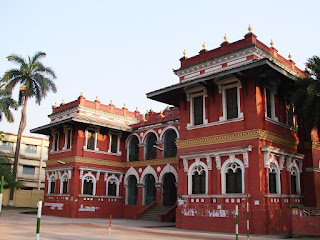 |
| Rajshahi College, Rajshahi. Bangladesh wikimapia.org/ |
 |
| Rajshahi College, Rajshahi.Bangldesh behance.net/gallery |
 |
| Rajshahi College, Rajshahi.flickr.com |
Above image: Rajshahi College, Rajshahi, near Dhaka, Bangladesh
The bright-red colored building is the main administrative block of the college built in 1884 and is a classic example of Indo-European architecture. Note the overhanging eaves continuous all along above the windows providing protection against sun and rain. It is a masonry building with just one first floor and both this and other buildings have high ceiling and lots of windows to keep indoors cool. Other important older buildings of the colonial period include the Fuller Hostel Biology Building, Chemistry Building, Physics Building, former Muslim Hostel etc. All the buildings are traditionally red-colored. Deep-red is the favorite color widely used in the buildings on campus. On the south side of the campus is the red-colored principal's residence. The European features are arcaded windows, pointed windows and entrances. Large slanting sunshades or hanging eaves are provided in places on the upper floor to avoid sun glare and rain water. On the terrace along the edge, the parapet walls carry decorative art works. In some building the wide verandas cut down heat and radiation from outside and it will make the occupants inside the classroom cool. An interesting fact is the native design styles are not incorporated in a conspicuous manner. The absence of onion-shaped domes, jarokaha, Chatries, lattice windows suggest blending of vernacular architecture was yet to gain popularity in this region. Indo-saracenic features common in South India are not noticed in this region. The arcaded window, a typical European design element was common in Renaissance Italy, This type of window design was widely adopted in church buildings in India during the colonial time.............................
 |
| Rajshahi College, Rajshahi, Bangladesh.ommons.wikimedia.org/ |
 |
| Rajshahi College, Rajshahi. Bangladesh flickr.com |
Above image: Rajshahi College, Rajshahi,Bangaladesh- Note the arched pointed windows with sloping chajjas - sunshade, decorative parapet and cornice. In the top single floor small structure with elevated base with numerous symmetrical arches, the hanging eaves are supported by brackets..............
Established in 1873 in Rajshahi city, in Bengal (now part of Bangladesh) under the British Crown administration 15 years after the first war of independence -m 1857-58, Rajshahi College, Rajshahi, is the third oldest college in Bangladesh after Dhaka College and Chittagong College, offering undergraduate degrees.
Raja Haralal Roy Bahadur of Dubalhati not only gave financial support but also donated land for the institution.
It was the first institution to award master's degree in this region in 1895. Now a popular college, it had a humble origin as a private
English School in 1828 by the region's most prominent citizens who felt their children needed English education to progress in life under the British. Called Rajshahi Collegiate School) in 1836 it was put under the control of the provincial government of Bengal and later became a Government Zilla (or District) School. As there was growing interest among the locals for higher education in 1873, the school elevated to the status of an Intermediate College, and F.A (equal to Intermediate Courses offered in many Indian colleges prior to 1950s). It became one of the important centers of education in this part of East and North Bengal, Assam and Bihar.
Accorded a first-grade rank in 1878, the college that was headed by F T Dowding as the principal of the college in 1879, saw further upgradation that gave it the right to offer BA course under the University of Calcutta. Raja Promothnath Roy Bahadur of Dhigapathia, as the founder president of Rajshahi Association donated gave Rs 150,000, a whooping sum in those days to the government for introducing Degree programme in the college
"Rajshahi College" progressed well and in 1883 it began classes in MA and B.L. The year 1881 saw the inauguration of the M. A. classes; B.L. The college had just 200 students (from 6 from its inception) and in 1924 the students enrolment crossed more than 1000. Now, it is part of the national University System in Bangladesh.
Some interesting facts are to impart Sanskrit education in
1905, the Moharani Hemantakumari Sanskrit College was established under the administration of Rajshahi College. The unique thing was Sanskrit was taught without tuition fee. In 1910 Raja Krishnananda Hall, auditorium of the college came up to conduct meetings, seminar, discussions, etc.Thanks to the munificence of Kumar Sharadindu Ray of Balihar. Many buildings on the campus came through donations from the generous rich people.Set on a huge land comprising more than 35 acres of lan, it is a leading educational institution now.









